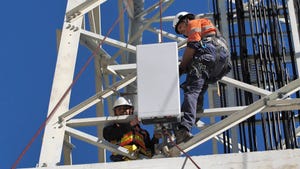DoD hints at 'paid-for relocation' in lower 3GHz
The Pentagon's CIO, John Sherman, said the military would consider 'potentially some limited, paid-for relocation,' in order to free up the lower 3GHz band. Meanwhile, the 5G industry is fretting over wasted time.

A top official at the US Department of Defense (DoD) said the agency would consider moving some of its airborne radar operations off the lower 3GHz band in order to free it up for 5G operations.
"We're also going to look at some other aspects, potentially some limited, paid-for relocation, perhaps for future airborne radars," said DoD CIO John Sherman at an NTIA event this week. "We're going to check this out here, and really try to turn over every rock we can on this, because we know the criticality … about the very close unity of commercial and military success."
However, Sherman reiterated the Pentagon's preference for spectrum sharing – rather than relocation – in the lower 3GHz band. He did not provide any details on how much spectrum the DoD might be willing to give up under a relocation program, nor did he indicate how long relocation might take. Presumably any such movement would only involve "future" airborne radar operations, leaving a question over what might happen to existing operations.
The potential for "paid-for relocation" is important because the US 5G industry is keen to move military users off the lower 3GHz band so it can be repurposed for commercial operations. Paying for such a shift is a familiar concept in the telecommunications industry as spectrum auction revenues are often used to relocate incumbent users to other bands.
US military officials, in past remarks on the topic, have resisted calls for the DoD to release any spectrum in the lower 3GHz band. Instead, they've only been open to spectrum sharing scenarios.
A 'moon shot'
Sherman made his latest comments Thursday in a keynote address to the NTIA's newest Spectrum Symposium, the agency's sixth such annual spectrum event, held in Washington, DC. This year's symposium is the NTIA's first major public spectrum event following the release of the Biden administration's national spectrum strategy late last year. That document puts the NTIA squarely in charge of handling spectrum coordination between federal and commercial users.
"The lower 3GHz is too important not to be able to use," Sherman said during his seven-minute keynote presentation.
Sherman said US Navy ships are currently using radar in the lower 3GHz band to protect international shipping from Houthi attacks in the Red Sea. That work shows how critical the spectrum band is for military operations, he said, noting that soldiers use the band in the US during training.
But Sherman said the DoD remains open to sharing the band with commercial users.
"We're going to be looking at something called Dynamic Spectrum Sharing," he said. "We have to figure DSS out."
Sherman described DSS as a "moon shot" that, if successful, could put the US ahead of China in the development of advanced spectrum management technologies.
Finally, Sherman suggested that the DoD remains open to working with academia, commercial companies and others to implement sharing.
"There's ways we can work together," he said, adding that the US military is invested in the development of 5G technology in general. Indeed, recent legislation requires the DoD to deploy 5G networks on US military bases. Further, the DoD continues to invest in open RAN, 5G and other technologies in order to coordinate military communications across branches from the Marines to the Air Force.
Sherman ended his remarks by saying that "we're in the same line of business." The goal of the military, the NTIA and others is generally the same: to ensure the US remains competitive on an international stage, he said.
Two years 'lost'
Prior to Sherman's keynote, a top official in the 5G industry said during the symposium that the US military so far hasn't been open to releasing spectrum in the lower 3GHz band. Umair Javed, senior VP for spectrum at wireless industry lobbying association CTIA, said during a panel discussion that the DoD has already looked at the topic of spectrum sharing via its Emerging Mid-Band Radar Spectrum Sharing (EMBRSS) report. After almost two years of work, that report was finished late last year, but it has not been publicly released.
"We lost two years, and we need to make up for lost time," Javed said. He noted that Biden's new spectrum strategy calls for "additional studies" on sharing in the lower 3GHz band.
"The time was not lost," countered Jennifer Warren, VP of regulatory affairs for Lockheed Martin, the Pentagon's biggest contractor. Speaking about the DoD's report on sharing in the lower 3GHz band, she said that "the outcome was not what one community wanted."
Javed asked if she was referencing the White House. She said no, she was talking about the CTIA.
"Everything is not defined by 5G, high-powered, wide-area networks," Warren continued. She said big US wireless network operators like AT&T and T-Mobile – companies represented by the CTIA – aren't the only players that must be considered in a discussion of spectrum users and uses.
FCC official Jonathan Campbell, speaking on the same panel, sought to find some common ground. "There needs to be clarity and reliability of whatever comes out of this process," he said. "That's going to require a lot of work from us."
Indeed, the FCC's auction authority has been in limbo for roughly a year due to the ongoing debate over whether and how to release the lower 3GHz band for 5G.
The difficulties of sharing
Although executives, regulators and others have been discussing the topic of spectrum sharing in the lower 3GHz band for years, so far there has been little progress. During another NTIA panel session – one featuring officials from the DoD, the NTIA, Google and other players – panelists noted that the parameters of spectrum sharing in the lower 3GHz band remain vague at best.
For example, Andrew Clegg, Google's spectrum lead, said sharing technologies are still being worked out in the 3.5GHz CBRS spectrum band. He said there was no way that advanced sharing technologies could be developed and implemented for the lower 3GHz in the next year or two.
There are a variety of spectrum sharing scenarios that have either been discussed or implemented in the US wireless industry. For example, operations in the CBRS band rely on Environmental Sensing Capability (ESC) networks that scan for military operations and then work with spectrum administrators to move commercial users to other parts of the band.
But another technology – Incumbent Informing Capability (IIC) – promises to enable the DoD and other federal spectrum users to submit information, reliably and securely, about when and where they would be employing certain frequencies. That technology remains in development.
The issue is critical to the US wireless industry, whose executives argue that the industry needs more midband spectrum to continue developing new services like fixed wireless.
About the Author(s)
You May Also Like












